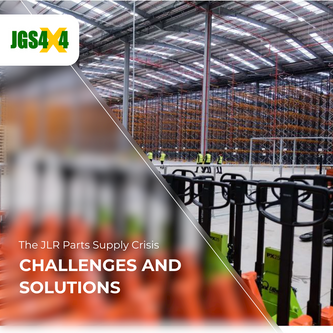The JLR Parts Supply Crisis: Challenges and Solutions
We have been affected by the shortage in Genuine Land Rover parts both through our business supplying parts and accessories for Land Rover owners and on a personal level, being unable to get parts for our personal Land Rover vehicles.
But why is Jaguar Land Rover (JLR) facing significant challenges in its parts supply chain? These issues have impacted dealerships, repair centres, and, ultimately, JLR customers. In this blog post, we delve into the problems, their causes, and the steps being taken to address them.
The Backlog: A Critical Situation
The Transition: JLR downsized its UK parts supply network from 18 warehouses to one central hub – the Mercia Park complex in Leicestershire, operated by logistics partner Unipart Logistics.
The Crisis: Since the transition began in Q4 2023, there has been a crisis in parts supplies for Jaguar and Land Rover dealerships. Thousands of cars have been parked, awaiting critical components.
Loan Car Shortage: The situation escalated to the point where JLR’s loan car fleet was exhausted, leaving affected customers without alternative transportation.
The Numbers Speak
10,000 Cars Affected: Around 10,000 customer cars across the UK are waiting for parts. These vehicles include both Jaguars and Land Rovers.
Dealers at Breaking Point: JLR workshops are at a “breaking point” due to the global parts shortage. Repair centres struggle to meet customer demands, affecting service quality and customer satisfaction.
Switching to the Super-Center: While the new super-center was intended to streamline operations, the transition has been far from smooth. The benefits are yet to be fully realized.
Why Did It Happen?
Supply Chain Restructuring: The shift from 18 warehouses to one central hub was a strategic move to improve efficiency and reduce costs.
Unforeseen Delays: Delays during the transition led to a backlog of critical parts. The bottleneck primarily occurred during the initial phase.
Dealer Capability: Even as the backlog reduces, the challenge is to ensure dealers can fix vehicles promptly.
The Road to Recovery
Reducing the Backlog: JLR has made progress, reducing the backlog to fewer than 2,000 parts by the end of January. However, the process of integrating these parts into vehicles takes time.
Adding Courtesy Vehicles: JLR has added 1,000 new courtesy vehicles to its network. If repairs take longer than expected, affected customers can at least use a JLR product during the wait.
Customer Impact: Unfortunately, many customers had to resort to non-brand vehicles during the crisis, affecting their experience.
The Way Forward
Commitment to Improvement: JLR remains committed to resolving the situation. The transition to the super-center is a long-term investment aimed at overall improvement.
Customer-Centric Approach: JLR acknowledges customers' inconvenience and aims to restore confidence by ensuring timely repairs.
Staying the Course: JLR will persist until things are better than before. The goal is to enhance the customer experience, not exacerbate it.
In conclusion, while the JLR parts supply crisis has been challenging, the company’s determination to overcome it demonstrates its commitment to quality and customer satisfaction. Let’s hope the road ahead leads to smoother drives for all JLR enthusiasts! ?✨
Recent Posts
-
25 Years of the Discovery 2 – A Modern Classic
Launched in autumn 1998, the Discovery 2 was a major evolution of the original Discovery and a turni …17th Jun 2025 -
Land Rover Wins the 1979 Dakar Rally – A Forgotten Victory
Did you know? In 1979, Land Rover achieved off-road racing glory by winning the very first Paris-Dak …20th May 2025 -
The Birth of the Land Rover Discovery – 35 Years Ago This Month
Did you know? In May 1989, Land Rover unveiled a completely new model that would become one of its m …14th May 2025




